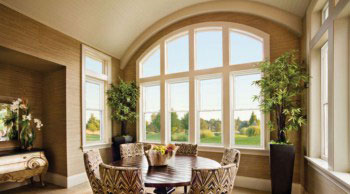Energy-efficient windows have become a crucial component of modern homes and buildings as the world focuses on sustainable and environmentally friendly practices. These windows play a vital role in reducing energy consumption, lowering utility bills, and minimizing the carbon footprint of a structure. Below we explore everything you need to know about energy-efficient replacement windows in Austin TX, from their benefits and features to the various types available in the market.
Energy-Efficient Window Benefits
The advantages of installing energy-efficient windows are multifaceted. One of the primary benefits is the significant reduction in energy consumption. These windows are designed to minimize heat transfer, which means they can keep your home cooler in the summer and warmer in the winter without constant heating and cooling.
Additionally, energy-efficient windows contribute to lower utility bills. By maintaining a consistent indoor temperature, they reduce the reliance on heating and air conditioning systems, resulting in considerable savings over time. This cost-effectiveness is a key factor that has led many to adopt energy-efficient windows in both residential and commercial buildings.
Moreover, these windows enhance comfort within the living or working space. They effectively reduce drafts and cold spots, creating a more comfortable and consistent indoor environment. This increased comfort can lead to higher overall satisfaction among occupants.
Energy-Efficient Window Features
So what are energy-efficient windows exactly? Several key features distinguish energy-efficient windows from traditional ones. One of the primary features is multiple glazing layers. Energy-efficient windows typically have two or more glass layers with an air layer (such as argon or krypton) between them. This design acts as an additional barrier against heat transfer, enhancing the window’s insulation properties.
Low-emissivity coatings are another crucial feature. These low-E coatings are applied to the glass surface to reflect infrared light while allowing visible light through. This coating regulates the temperature inside the building by preventing the escape of heat during cold weather and blocking the entry of heat during hot weather.
Furthermore, the window frames play a significant role in the overall energy efficiency. High-quality frames made from materials such as vinyl, fiberglass, or wood with thermal breaks contribute to reduced heat conduction. This ensures that the benefits of the multiple glazing layers and low-E coatings are not compromised by inefficient frames.
Types of Energy-Efficient Windows
- Double-Pane Windows
These windows comprise two glass layers with a sealed space between them. This space is often filled with air or an inert gas like argon. These windows provide better insulation compared to single-pane windows, making them a cost-effective choice for homeowners looking to improve energy efficiency.
- Triple-Pane Windows
Triple-pane windows take insulation a step further by incorporating three layers of glass. The additional glass layer enhances the window’s ability to resist heat transfer, making it an ideal choice for regions with extreme climates. While triple-pane windows offer superior energy efficiency, they are generally more expensive than double-pane options.
- Low-E Coated Windows
Windows with low-E coatings are designed to minimize the amount of ultraviolet and infrared light that can pass through the glass while still allowing visible light to enter. This feature is particularly beneficial in regulating indoor temperature and protecting furniture and fabrics from fading due to sun exposure.
- Gas-Filled Windows
Some energy-efficient windows have insulating gases between the glazing layers. Since these gases are denser than air, they reduce heat transfer and improve the overall thermal performance of the window.
- Frame Materials
The material used for window frames is a critical factor in determining energy efficiency. Vinyl, fiberglass, and wood are popular choices for energy-efficient window frames. These materials offer good insulation properties and can be designed with thermal breaks to further reduce heat conduction.
Installation and Maintenance
Proper installation is essential to maximize the energy efficiency of windows. A professional installer can seal and align your windows properly, preventing air leaks and heat transfer. Homeowners should also consider regular maintenance, such as cleaning the windows and checking for signs of wear or damage to the seals and frames. Timely repairs can help maintain the windows’ performance over the long term.
Choosing the Right Energy-Efficient Windows
Choosing the right energy-efficient windows is a critical decision that can significantly impact a building’s overall energy performance and the comfort of its occupants. Several factors should be carefully considered to ensure that the selected windows align with the specific needs of the space and its geographical location.
Climate Considerations
The local climate also determines the most suitable windows for you. We recommend windows with high-insulating properties, such as triple-pane windows for colder climates, where heating is a primary concern. These windows trap more heat indoors, reducing the reliance on heating systems. Conversely, windows that reduce solar heat gain reduction are ideal for warmer climates. Low-E coatings designed to minimize the entry of infrared light can help keep the interior cool while allowing visible light to pass through.
Orientation of the Building
Your building orientation and the direction of windows relative to the sun’s path can impact the overall energy efficiency. Windows facing the south receive more sunlight throughout the day, making them ideal for harnessing solar heat during the winter. In such cases, windows with a higher solar heat gain coefficient (SHGC) can be beneficial. On the other hand, east and west-facing windows are exposed to more intense sunlight during specific times of the day, and selecting windows with low SHGC values can help minimize heat gain in these areas.
Energy Star Certification
When in doubt, looking for the ENERGY STAR label is a reliable guide. The ENERGY STAR certification ensures that the windows meet stringent energy efficiency standards set by the U.S. Environmental Protection Agency. Products with this label have undergone independent testing, providing consumers with confidence in their energy-saving capabilities.
Budget Considerations
While energy-efficient windows can lead to long-term savings on energy bills, it’s crucial to consider the initial investment. Different energy-efficient windows come with varying price points. Homeowners should strike a balance between their budget constraints and the potential long-term energy savings.
Consultation with Professionals
Seeking advice from professionals in the field is invaluable when choosing energy-efficient windows. Energy consultants or window installation experts can assess the specific needs of a building, taking into account factors such as insulation requirements, local climate conditions, and budget constraints. Their expertise can guide homeowners toward the most effective and efficient choices for their unique circumstances.
Energy-efficient windows are a crucial investment for anyone looking to enhance the sustainability, comfort, and cost-effectiveness of their home or building. With the growing emphasis on environmentally friendly practices, energy-efficient windows are a responsible choice that contributes to a sustainable future.

